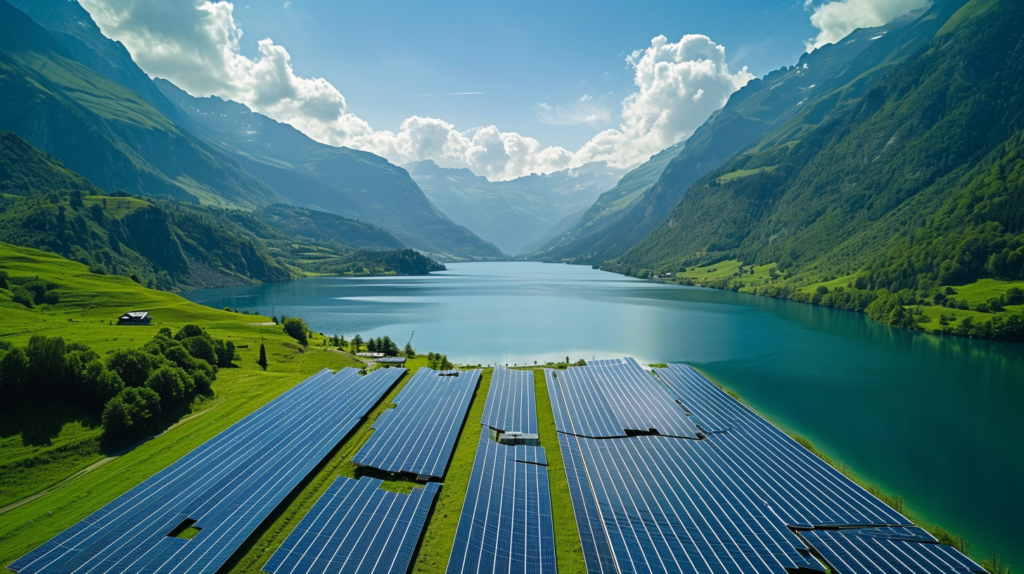Despite its small size, Switzerland has become a surprising world leader in renewable energy. The Alpine nation of just 8.7 million people has outpaced expectations and ranks among the top countries globally for the adoption of clean energy technologies.
Switzerland generates over 60% of its electricity from renewable sources, primarily hydropower, and is on track to phase out nuclear energy. The country aims to get 35-45% of its total energy from renewables by 2035 and is on its way towards the ambitious goal of net zero emissions by 2050.
Switzerland offers an inspiring model for the future – demonstrating how political will, public support, technological innovation, and significant investment can transform infrastructure in just a few decades. This article examines how Switzerland laid the groundwork to become a global leader for renewable energy adoption.
Table of Contents
I. Ambitious National Energy Goals

Switzerland’s rise as a renewable energy leader can be attributed in part to the country setting clear and ambitious targets for itself. Rather than vague aspirations, Switzerland has made firm national commitments to slash emissions and rapidly scale up renewable energy.
A. Specific Energy Targets
In recent years, Switzerland has codified specific renewable energy and emissions reductions goals into law following public referendums. Key targets include:
- Reduce greenhouse gas emissions by at least 50% by 2030 compared to 1990 levels
- Reduce emissions by at least 75% by 2040
- Reduce emissions by at least 89% for 2041-2050
- Reach net zero greenhouse gas emissions by 2050
- Increase non-hydro renewables like solar and wind to produce at least 17,900 GWh by 2035, nearly triple the current energy output.
- Ensure 35-45% of total energy consumption comes from renewables by 2035
- Increase hydroelectric power output to 37,400 GWh by 2035
- Phase out nuclear power plants by 2034
These precise targets help provide regulatory certainty for grid infrastructure planning while holding policymakers accountable. The goals also give companies and investors clear direction on Switzerland’s future energy mix as they make long-term plans.
B. Public Support Through Referendums
What’s notable about Switzerland’s renewable energy targets is that they reflect the will of Swiss citizens. Major policies like the phase-out of nuclear power and the net zero emissions goal were approved directly by public referendum, with Swiss voters overwhelmingly supportive.
For example, in 2017, Switzerland voted to gradually phase out nuclear power in favor of renewable energy sources following decades of public debate. More recently, Swiss voters backed the new Climate and Energy Innovation Act in 2023, which enshrines into law the 2050 net zero target and key milestones along the way.
This groundswell of public support for climate action and renewable energy has propelled policymakers to take ambitious steps that may have been politically difficult otherwise. Direct democracy has thus been a crucial ingredient in Switzerland’s renewable energy transition.
II. Major Clean Energy Investments and Incentives

Beyond ambitious targets, Switzerland has backed up its goals with major investments in renewable energy infrastructure paired with financial incentives to accelerate the transition.
A. Billions Invested in clean energy
To reach its lofty aims, Switzerland is pumping billions into scaling up clean electricity through public and private capital. Under the new Innovation and Climate Act, CHF 480 million ($500 million) per year will be raised from electricity consumers to fund renewable climate projects.
Much of this capital is flowing into solar, wind, geothermal, and advanced bioenergy projects through public-private partnerships. Switzerland is looking to increase solar power output more than eighteen-fold by 2050. The country is also examining options to expand wind power, including specialized turbines designed to operate in Alpine conditions.
On top of that, billions more have been invested in modernizing Switzerland’s substantial hydropower resources, which already provide over 60% of the nation’s electricity. Pumped storage hydropower stations act as massive batteries, storing energy for when demand peaks.
B. Environmental Incentives for Households and Businesses
Alongside public investment, Switzerland offers attractive incentives for households and businesses to install renewable energy systems or improve efficiency.
For example, residential solar panel installations are eligible for rebates up to 30% of costs. Feed-in tariffs provide guaranteed compensation for renewable power fed back into the grid by homeowners. Households can also receive thousands in subsidies for energy-efficient renovations, heating system upgrades, and e-mobility infrastructure.
For Swiss businesses and industries, tax breaks are on offer for energy efficiency investments that curb fossil fuel use. Subsidized audits help companies identify savings opportunities. Further incentives aim to spur corporate renewables adoption.
These financial carrots accelerate distributed renewable energy generation while allowing households and businesses to share the economic benefits.
III. Innovative Climate Technologies and Projects
Switzerland has also been innovative in piloting new renewable energy technologies tailored to its environment. Complex engineering projects demonstrate solutions that unlock more Alpine renewable potential.
A. Energy Storage and Hydrogen Power
With scarce land area for solar farms, Switzerland sees storage technologies like batteries and hydrogen fuel cells as pivotal to balancing variable renewables.
The country has invested heavily in battery research institutes and test facilities. Startups are piloting residential batteries coordinated through virtual power plant software to improve grid stability as solar proliferates.
Hydrogen is similarly seen as an important storage medium for surplus renewable energy. Switzerland is building high-altitude solar-to-hydrogen facilities to take advantage of abundant hydropower. The hydrogen can then be stored seasonally and re-electrified when required.
B. Pumped Energy Storage and Solar-Hydro Hybrids
As a mountainous country, Switzerland relies heavily on pumped storage hydropower, which accounts for over 99% of its grid storage capacity. Lake reservoirs act as giant batteries, pumping water uphill when electricity prices are low so it can flow back down to generate power during high demand.
Switzerland is now examining advanced techniques like underground pumped storage tunnels deep inside mountains. Pilot plants are also testing combining pumped storage directly with solar PV. These hybrid plants allow solar energy to pump hydro reservoirs uphill so it is immediately stored.
C. Floating Solar and Alpine Wind
Even while pushing pumped hydro capabilities further, Switzerland is innovating with other renewable technologies too. Recently added solar PV systems at high-altitude hydropower dams showcase floating solar panels tailored to freshwater. This allows otherwise unusable dam surfaces to generate solar power close to the existing grid connections.
Switzerland is also working to harness more wind power, including turbines designed specifically for Alpine conditions. Usually, wind power is prominent in coastal regions. But new medium-scale turbine models can utilize wind resources at higher altitude locations in Switzerland’s peaks where wind speeds average 25-27 km/h.
IV. Global Climate Leadership and Influence

Switzerland’s determination to phase out nuclear and fossil fuels while innovating in renewable technologies has begun to garner global attention. The country serves as a demonstration of how political commitment can unlock rapid transformations in energy systems.
A. Inspiring Other Countries
Switzerland’s ambitious legally-enforced targets, the concrete timeline for nuclear phase-out, and citizens pushing the renewable transition have caught the eye of policymakers worldwide.
In particular, Switzerland’s ability to move fast on scaling renewables despite not belonging to supranational blocks like the EU inspires questions around just how quickly energy infrastructure can evolve in coming decades. Countries long reluctant on climate issues are being challenged to pick up the pace.
Of course, as a rich nation, Switzerland has advantages. Yet its model for incentivizing distributed renewables has brought policies like solar feed-in tariffs to the mainstream. Overall, Switzerland shows that rapid progress is possible when politicians commit to long-term targets and citizens participate directly.
B. Showcasing 100% Renewables Energy Feasibility
Some analysts argue reaching 100% renewable energy across entire countries simply isn’t possible with current technologies. Switzerland’s progress so far rebuts this notion.
Already, Switzerland has proven that existing off-the-shelf technologies allow societies to reach extremely high renewable penetration while maintaining grid stability. With continuing cost declines in batteries, solar, hydrogen, and other innovations, Switzerland shows that 100% renewable energy is ultimately achievable at a nationwide scale.
C. Sustainable Climate Development Model
More broadly, Switzerland illustrates how to transition energy infrastructure rapidly and equitably without derailing quality-of-life improvements. The Swiss model balances affordability, reliability, and sustainability without forcing harsh trade-offs.
In fact, coupling the energy transition with smart urban planning and nature conservation efforts actually enhances livability in Switzerland. The country has managed to decrease annual GDP while reducing per capita emissions by over 30% since 1990 as renewables replaced fossil fuels.
With the global community needing to overhaul energy systems while protecting prosperity, Switzerland’s ability to spawn green technologies, create jobs, uphold supply security, and conserve natural capital signals a blueprint.
V. Climate Challenges Going Forward
Make no mistake – while Switzerland has made huge strides, major obstacles remain to realize its decarbonization vision. Policymakers cannot become complacent. As renewable scaling intensifies, Switzerland faces growing pains around transmission capacity, land use constraints and maintaining public consensus.
A. Upgrading Energy Grid Infrastructure
To balance rising wind and solar inputs across its regions, Switzerland must upgrade grid connectivity speedily and equitably. Proposed transmission corridors that concentrate infrastructure in low-income areas have met local opposition. Streamlining permitting while enhancing compensation schemes can help smooth new tangled lines.
Advanced grid technology investments that leverage artificial intelligence and big data analytics may equally ease Switzerland’s balancing act as variable inputs balloon.
B. Managing Land Use Tensions
With a limited land area, Switzerland also faces land use tradeoffs in finding space for more solar farms, wind turbines, batteries, and transmission wires. Careful spatial planning is instrumental in minimizing biodiversity impacts or destruction of recreational spaces as new energy hardware gets deployed.
Policies that encourage rooftop solar combined with dual-use solutions like agrivoltaics, which co-locate solar infrastructure on farmlands, help alleviate land pressures. However, continued expansion of renewable power will require setting aside more dedicated land, requiring legislation to balance community and climate priorities.
C. Maintaining High Public Support
Finally, Switzerland may struggle to maintain the high levels of public approval that initially catapulted its energy transition. As subsidies ramp up and grid connections multiply, costs passed on to consumers in electricity bills could gradually erode support. And as households are asked to make their own tangible lifestyle sacrifices around travel and diets, Switzerland risks pushback.
Sustaining Swiss citizens’ remarkable unity around emissions cuts and renewable adoption as policy impacts widen will be a key challenge. Communication campaigns that reinforce the opportunities of green jobs, technologies and enhanced quality of life will help consolidate the energy transition’s durability.
Conclusion

Switzerland’s trajectory over the past decade serves as an inspiration. The country’s citizens, scientists, and policymakers have joined forces and defied expectations about the speed at which an industrialized nation can usher in renewable technologies to improve wellbeing for everyone.
Key factors like engaged public referendums, forward-looking policies, R&D funding, and incentives unlocked Switzerland’s renewable leadership. While hurdles remain, the nation is firmly on the path to 100% clean power. Other countries would do well to consider the Swiss playbook as they shape their own energy futures.
With breakthroughs in renewable costs and innovation, Switzerland gives the world hope. Its progress demonstrates that with supportive regulation, financing, and social license, decarbonization by mid-century is feasible. If a small Alpine country can harness enough zero-carbon power to match the economy’s needs just decades from now, what excuses remain for others?
As climate urgency reaches a fever pitch, Switzerland’s clean energy advances could not have come at a better time. The country punches far above its weight in showing societies everywhere what might be possible – if we dare set audacious goals and actually execute solutions with conviction. The Swiss model can spark a vital realization across boardrooms and policy circles globally: that unstoppable momentum toward 100% clean energy is finally within reach if we choose to unleash it.

